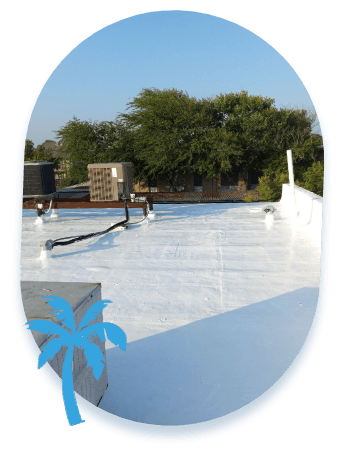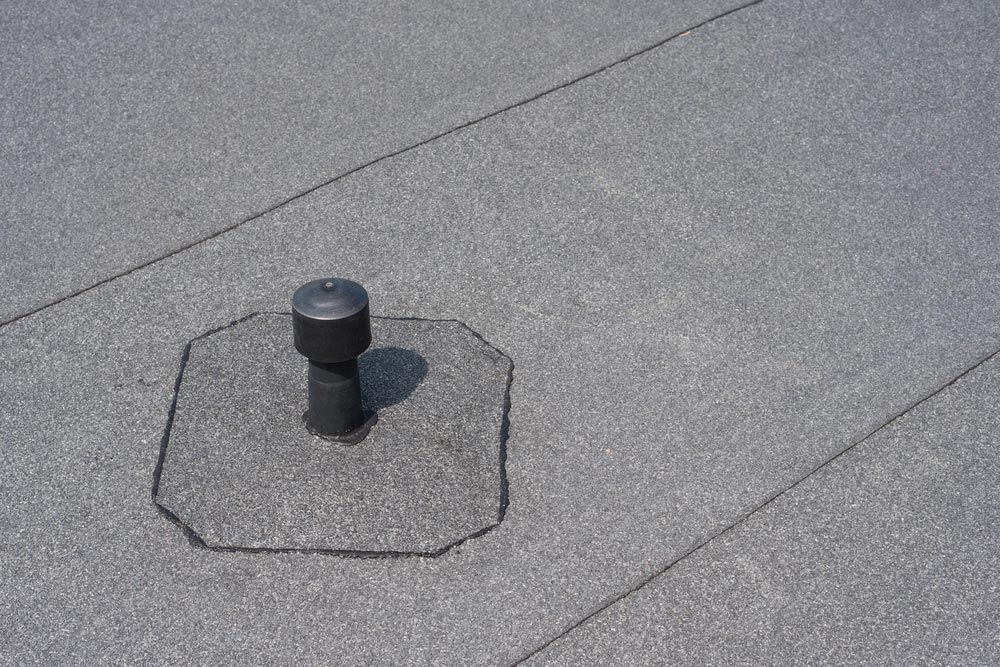The primary purpose of any roofing system is to maintain the structural integrity of a building by keeping its contents from getting wet. While its function is simple, the variety of flat roofing systems that are available today is far from it. The market for these types of roofs has grown tremendously in the last 50 years. Flat roofs aren’t a new thing, and the same is true for many of the materials being used in their construction.
 They’re often used on commercial spaces that are more concerned about function than aesthetics, which can include:
They’re often used on commercial spaces that are more concerned about function than aesthetics, which can include:
- Factories and warehouses
- Brick-and-mortar stores
- Apartment buildings
- Large public buildings
- Schools and universities
The design of a flat roof is as economical as it is efficient, which is why it’s often used in these types of spaces.
Types of Flat Roofing Systems
There are four main types of flat roofing systems, which will vary in price according to their size and structure. The flat roofing types that you can choose from include:
- Built-Up Roofing (BUR) — This traditional hot-tar-and-gravel system is built up from three or more layers of waterproof material that are coated with hot tar and are ballasted with a layer of smooth stone. While they were once made of tar paper, modern systems are using more advanced materials (such as fiberglass membranes).
- Modified Bitumen — this roofing system is made of a single layer of rolled-up material that’s similar to a shield made of ice and water, and it’s fused with a mineral-based wear surface. Torch-down systems involve the application of adhesive mixed with heat while it’s being unrolled, but a more modern peel-and-stick system is safer and easier to install.
- Rubber Membrane — Also called EPDM roofing, this rubber-based system is made of a durable material that looks like an inner tube. But it’s meant to be resistant to sun damage. It can be either mechanically anchored with fasteners, ballasted with stone, or glued directly to the roof deck.
- PVC Roofing — This type of flat roofing is as reflective as it is durable. PVC is one of the best options for this type of roofing because it’s easy to install and is impenetrable to water. It can also eliminate the risk of water ponding, which can damage the building’s interior. But because it’s applied in rolls, it can leave seams on the surface (which can eventually lead to roof failure). They need to be taped or glued together, which can resist water for a while but not for more than 10-15 years.
Be sure to speak to a roofing professional for more information about the different flat roofing types.
Qualified Commercial Roofing Contractors in the Coastal Bend!
If you want to work with one of the most qualified commercial roofing contractors in the Coastal Bend, Bayfront Roofing and Construction has you covered. We have a team of professionals with years of combined experience in all areas of roofing, so we can handle any type of project. That’s why we’re one of the best commercial roofers in Corpus Christi. Whether you need a new roof or want to repair the one you already have, feel free to get in touch with us. We would be happy to speak with you!
Flat Roofing Systems FAQ
Whether you’re a homeowner, property manager, or contractor, this FAQ aims to provide clear, concise answers to help you better understand flat roofing systems. Our goal is to simplify the complexities of flat roofs and ensure you have the knowledge needed to choose the right solution for your project.
What can cause my flat roof to leak?
Any of the following can cause flat roofing leaks:
- Poor installation.
- Aging.
- Membrane damage.
- Sealant deterioration.
- Blocked drains (which cause water pooling).
- Flashing issues.
- Lack of maintenance.
- Extreme weather conditions.
- HVAC installations.
It’s not a good idea to fix these problems yourself because of the risks involved. You should contact a professional to take care of these issues.
How do I know if my flat roof has a leak?
If you see water stains on your ceiling, measure the distance from the two nearest walls. Climb on the roof and apply these interior measurements to the exterior. Take a look at the area where the stain is appearing inside. If you don’t see any damage above the stain, search up the slope from where it’s located. Any obvious holes or cracks will most likely be the source of the leak. You should also patch any areas that look worn out, because they will leak eventually.
How can I fix minor cracks or holes on my flat roof?
If the area you need to work on is wet, dry it with some old cotton towels before sweeping the roof clean. Cut open any blisters or bubbles that may have formed on the membrane with a utility knife. Be sure to trim them closer to the membrane where it’s still attached to the roof deck, and don’t trim any part of the roofing material that’s still structurally sound. You also want to scrape off any other damaged roof material.
Spread 1/8 of an inch of roofing cement over the repair area with a trowel, and smooth it to at least six inches beyond the damaged area. Cut a piece of fiberglass mesh to fit the repair area and lay it onto the roofing cement. Spread more cement over the mesh until it’s no longer visible, and sprinkle gravel over the fresh cement. The small stones will keep the patch from being damaged by the sun. If you see any cracks along the edges of the roof, you can fill them with caulk.
How can a flat roof be resealed?
If you want to make your current flat roofing system more waterproof, you might be able to reseal it. Depending on what type of roof you have, you want to consider using an aluminum or silicone coat. Here are the steps that are needed to apply a flat roof coating:
- Clean and clear any drains, waterways, and other areas on your flat roof.
- Replace any drains if needed.
- Fill any cracks, holes, or damaged areas with a roof patching compound or sealant that’s compatible with your roofing material.
- Allow the patching to cure according to the manufacturer’s instructions.
- Apply a good amount of sealant to the roof with a paint roller moving in a single direction.
- Wait approximately 24 hours for the coat to dry.
You don’t want to apply the sealant if there’s any chance for rain in the next 48 hours, and it’s not a good idea to apply it in areas that don’t have enough drainage. You don’t want to apply it over gravel, rubber, or PVC sheet roofing. It also won’t work on shingles of any kind, as well as any old roofs that are too dry and brittle to withstand the shrinkage stress caused by applying these substances. For any serious leaks, you should contact a professional.
How long does a flat roofing system last?
The exact lifespan of your flat roof will depend on what has been installed, but most systems should last 25-30 years. Be sure to speak to a professional for more information.
What are some of the common types of flat roofing systems?
Some of the more popular flat roofing systems include the following:
- TPO — This type of flat roofing consists of a single-ply membrane that’s waterproof, UV resistant, and extremely durable. It can be used in a variety of low-slope commercial roofing applications, and it’s a sustainable roofing solution for a number of building types.
- EPDM — Also called “rubber roofs,” they’re known for their durability and their ability to withstand a variety of climates. The material is made out of recycled rubber tires and can work in low-slope designs. This makes it perfect for both residential and commercial applications. They can also last 30 years or more with proper maintenance.
- Modified Bitumen — This is a sturdy but flexible asphalt membrane that’s mixed with polymerized plastic and a fiberglass reinforcement. It’s a popular choice for commercial roofing systems and can last up to 30 years. It’s also known for being resistant to punctures, tears, and hail.
If you’re looking for one of the best roofers in Corpus Christi, be sure to get in touch with Bayfront Roofing.
